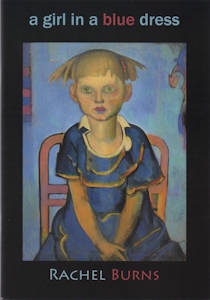In a girl in a blue dress, Rachel Burns charts the struggles, traumas and adventures of her girlhood and motherhood.
Her world is one of wonder and curiosities juxtaposed with the realities of working class life in the hinterlands of County Durham. Burns deals with her subjects without sentimentality, creating poems that fizz with a fusion of clarity, raw lyricism and an incisive, dark wit.
From the first poem, Rachel and The Seven Wonders of the World, the title suggests the adventurous spirit of a voracious reader. She won’t even let food prepared by her father get in the way of her focused and arguably essential escapism.
He puts the sandwich down with a glass of milk
at my feet. I don’t have time to eat.
I read on and on, hurling myself through
the beautiful tiled Ishtar Gate…
This need for escapism is poignantly revealed in her disturbing poem, The Dolls. The ‘he’ of this piece is someone to be feared in the cold and unsettling setting of her family home: “The Dolls were scared but they had to be quiet/because if he caught them crying they would/be for it so she would help them stay quiet/she would close all their eyes…”
This, we find out, was a home “where icicles form in silhouettes on the inside of bedroom windows”.
The third person point of view increases the threat and drama of this devastating domestic scene, a threat that Burns skilfully builds towards its defiant conclusion.
...she can hear him shouting
I haven’t finished with you yet and Mammy’s sobbing getting
louder and louder and she wished they’d stop because
They’re upsetting the Dolls and that makes her cross.
By closing the psychic distance between the narrator and the ‘she’ of the poem, Burns uses intimacy and narrative voice to great effect.
Meanwhile, in Teenage Pregnancy, Burns exemplifies the absolute fear of a young mother about to give birth after calling an ambulance from a phone box when her waters break. Later, in the hospital, we learn that the unborn baby is in danger after the mother has been left in a room for 12 hours. “The baby’s in distress – /we have to get it out now”.
And if this isn’t traumatic enough, she is then viciously patronised for her perceived mistake.
The midwife complains
about having to deliver babies
to silly teenage girls who don’t go
to ante-natal classes and don’t do
as they are told.
Fearing her baby might be dead, the young mother is too traumatised to take her baby in her arms (I’m too scared to look at him). This final line is a brilliant example of how Burns often closes her poems with simple intensity.
Elsewhere in the pamphlet, Burns details the struggles of her adulthood in a reflective and, again, devastating poem, Demolished, which explores the demolition of the benefits office where she once went to seek help in desperate financial times: I remember going cap in hand to the DSS for a crisis loan…
 But it’s the finer details of her poverty that mark this poem out as perhaps the most shocking poem in the pamphlet.
But it’s the finer details of her poverty that mark this poem out as perhaps the most shocking poem in the pamphlet.
There was no money, the rent was due,
you’ve not eaten for days,
the bairn is out of nappies,
you were scraping the bottom of the SMA
baby milk tin, literally.
And once again, the ‘I’ of the poem is subjected to demoralising condescension.
You hold the baby up to the security glass
she looks at you both
like dirt and tuts, tut, tut tut.
Burns’ collection consistently delivers poems with intensity and power, in a tone which is often matter of fact and never overstated. The poet captures the experience of someone brought up in poverty and how, often, some of those struggles persist into later life.
This is a brilliant and varied debut pamphlet which stays with the reader long after the last page. The more challenging moments are portrayed with an honesty and a beguiling defiance that can’t help make me feel excited about what Rachel Burns will come up with next.
By Mark Connors, Poetry Correspondent
A girl in the blue dress is published by Vane Women Word Web and available to buy here.




